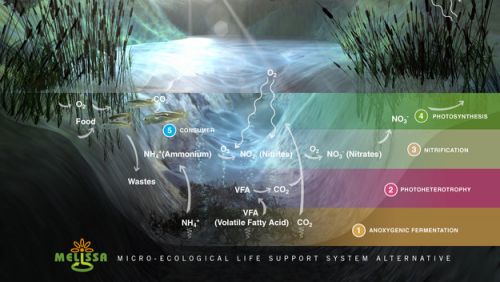
03/09/2015
Travelling to Mars Is In Progress Near the Barcelona Synchrotron Park
Travelling to Mars Is In Progress Near the Barcelona Synchrotron Park
Recently, an original experiment carried out on the International Space Station was exposed by the media: astronauts tested in August the first vegetable ever cultivated into space (a salad) as part of a NASA experiment to help prolong manned missions.
Some hundred meters horizontally far from the Barcelona Synchrotron Park (BSP) - and not 400 km above it -, the MELiSSA pilot plant from the European Space Agency (ESA), which is located in the engineering school of the Universitat Autònoma de Barcelona (UAB), the BSP strategic partner, works on a similar but much more ambitious project.
During a round-trip voyage to Mars, a six-person crew would need about 30 tons of food, oxygen and water for the 1,000 days mission. This huge quantity would be drastically reduced if a closed loop system would recycle the CO2 exhaled and the waste produced by the crew in order to produce in return oxygen, water and food, etc.: this is the MELiSSA project.
This project started 20 years ago and is founded up to 60% by the ESA (5 million Euros per year). It involves 100 researchers from 30 organizations and 15 European countries. In this puzzle the UAB pilot plant, which was inaugurated in 2009, plays a central role and will soon take a new important step: living beings will be introduced in the plant in order to test some parts of the artificial ecosystem. Rats, not astronauts, at the moment.
http://www.esa.int/Our_Activities/Space_Engineering_Technology/Melissa
Some hundred meters horizontally far from the Barcelona Synchrotron Park (BSP) - and not 400 km above it -, the MELiSSA pilot plant from the European Space Agency (ESA), which is located in the engineering school of the Universitat Autònoma de Barcelona (UAB), the BSP strategic partner, works on a similar but much more ambitious project.
During a round-trip voyage to Mars, a six-person crew would need about 30 tons of food, oxygen and water for the 1,000 days mission. This huge quantity would be drastically reduced if a closed loop system would recycle the CO2 exhaled and the waste produced by the crew in order to produce in return oxygen, water and food, etc.: this is the MELiSSA project.
This project started 20 years ago and is founded up to 60% by the ESA (5 million Euros per year). It involves 100 researchers from 30 organizations and 15 European countries. In this puzzle the UAB pilot plant, which was inaugurated in 2009, plays a central role and will soon take a new important step: living beings will be introduced in the plant in order to test some parts of the artificial ecosystem. Rats, not astronauts, at the moment.
http://www.esa.int/Our_Activities/Space_Engineering_Technology/Melissa
More news
24/07/2019
Port de Barcelona will have a rolling highway terminal
04/07/2019
New software to promote urban district heating and cooling networks
07/06/2019
Biodiversity in danger: Barcelona Synchrotron Park’s actions
28/05/2019
The UAB ranks first according to the CYD Foundation
23/05/2019
Alba: open day, workshop and last results
25/04/2019
The UAB Scientific and Technical Services: an opportunity for BSP’s companies









